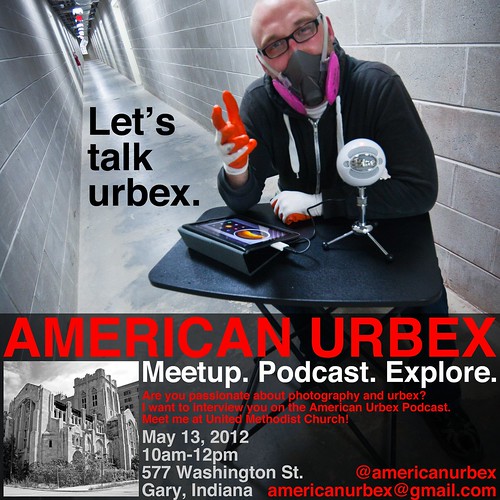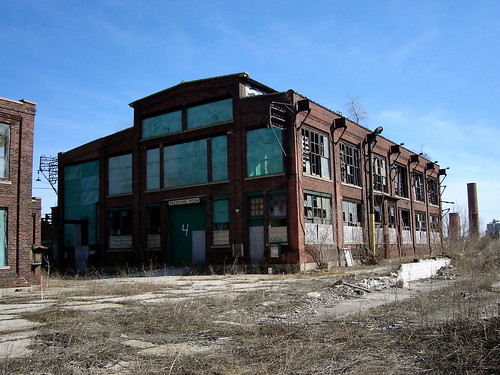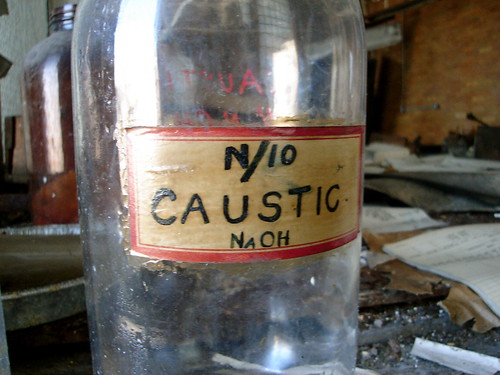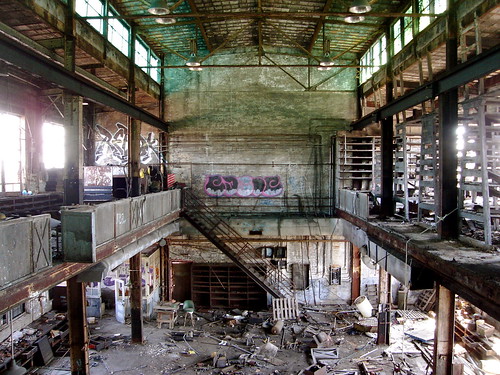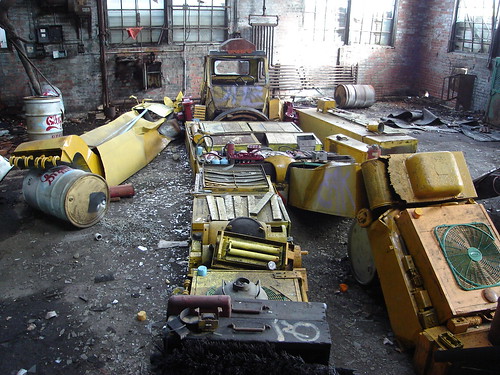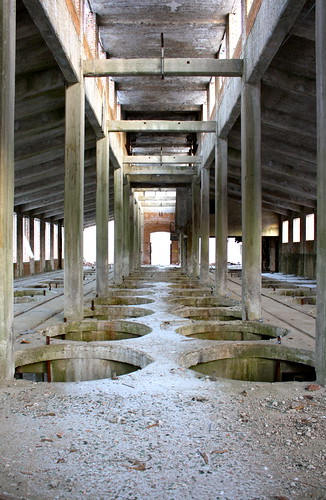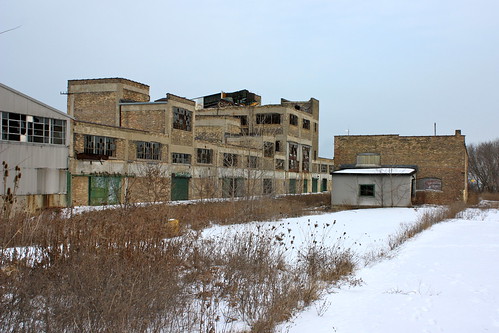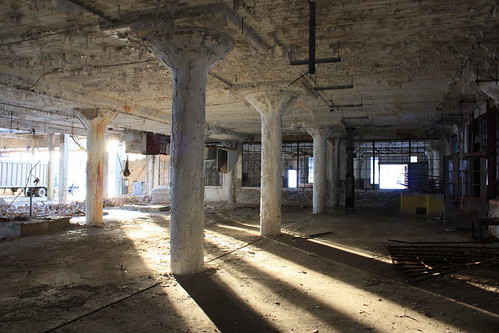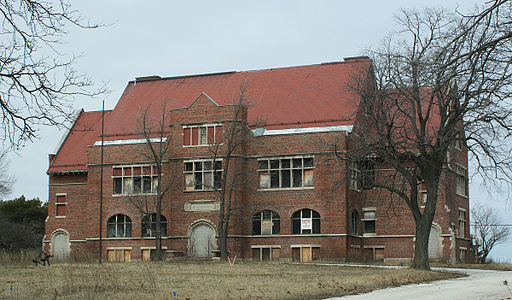
Photo (source): The administration building.
Wisconsin has a strong cultural background in agriculture. One of Wisconsin’s first attempts at providing technical education resulted in the Milwaukee County School of Agriculture and Domestic Economy in Wauwatosa. The site of the former high school enjoys protected status on the National Register of Historic Places, State Register of Historic Places, and is a Milwaukee County Landmark. According to the Google Map above it may look like there is plenty of activity at the location, but in reality the buildings have been long abandoned. The roads leading up to the campus were stripped away after the satellite image was taken.
In 1912 Milwaukee County had the largest rural populations in the state and opened the School of Agriculture and Domestic Economy. To build the school the county purchased 206 acres of land five miles west of downtown Milwaukee for $72,100 (or $350/acre). Milwaukee architect Alex C. Eschweiler was tapped to design the main campus Neo-Gothic style facilities. Structures for the school include four class buildings, one administration building, a dormitory, power house, barn, greenhouses, poultry sheds, and other smaller buildings.
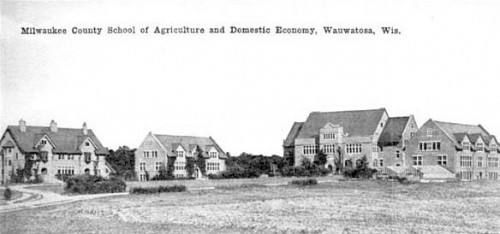
Photo (source): The five buildings designed by Eschweiler. The building to the far right in the photo has been demolished.
The high school focused on areas of study specific to agriculture. Students were given hands-on technical training, such as this practical example of how to build a farm shed. Graduates of the school were given a leg up for enrollment in the University of Wisconsin System thereafter. Milwaukee Country residents could attend the school free of charge, while non-residents paid $27 for tuition. Heavy advertising and early momentum lead to strong enrollment for the 1912-13 school year with 243 students. By the next 1913-14 school year, however, enrollment dropped to 206. 1914-15 saw enrollment precipitated further to 191. Average class attendance rates were even less than that ranging from 118-146 (source). Attendance dwindled continuously until 1928 when Milwaukee County concluded that it could no longer justify the cost of operating the school.

Photo (source): The area around the campus buildings has incredible biodiversity.
In 2007 then county executive (and current WI Governor) Scott Walker (R) opened the buildings for use by SWAT officers to host a training conference. This decision drew the ire of local preservationists attempting to save the location. One report states that paintballs were fired and caused damage to some of the interiors.
As of December 2010 the University of Wisconsin Milwaukee made a significant move to develop the site as an Innovation Park. The UWM group plans on making installments totaling $13.55 million to be paid by 2014. The Eschweiler designed buildings are expected to be sold to a private group for conversion into apartments. There are skeptics that have been quite vocal about the infeasibility of the impending sale. For better or worse, the sale of the property mandates renovation of the Eschweiler designed buildings. Another groups of environmentalist critics seek to defend the property because it is part of the threatened Monarch Trail.

Photo (source): The monarch butterfly uses the yellow shaded portion that borders the school as a stop on their migration towards Mexico.
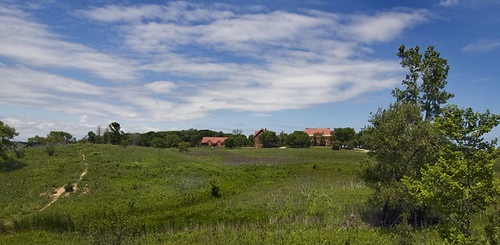
Photo (source): Beautiful park area surrounding the school.
While researching this location online sources mention that these buildings were later used as a tuberculosis clinic and/or mental hospital. The location is often conflated with the Muirdale Sanitorium, which is now a part of the Milwaukee County Research Park. Groups interested in preserving the location make no mention of the location being used for medical activities when writing about the history. Another general misunderstanding about the former School of Agriculture buildings involves the closest structure to the site, which is currently occupied by the Milwaukee County Parks Department. This structure actually used to be the location of the the Milwaukee Home for Dependent Children in the 1940’s. These mistakes are forgivable, but the websites that claim the School of Agriculture is haunted do this location a severe disservice to its history.
The campus buildings have signs stating that the area is under surveillance. The doors are either bricked off or bolted shut. To prevent access even the highest windows are boarded up. When I first visited in April of 2008, however, one of the doors was wide open. We wandered through the building and found mostly emptiness. Unfortunately my point and shoot camera battery died, so I don’t have very many photos. The ones that I was able to take are of poor quality due to the darkness. After we explored the first building I wondered about how we could make it into the others. My gut told me that each building may be connected via a network of tunnels. We went to the basement and my instincts proved to be correct. There really wan’t a whole lot left on the inside. Some of the buildings had power and a few lights on. One had an operational telephone closet running in it. The most interesting though was the administration building. At the very top is a beautiful chapel, which has been covered in graffiti. I returned a few months later in 2008 only to find my means of ingress had been bolted shut. Whatever the future has in store for this location the park area is a great place to spend an afternoon.
Resources:
All Business – Article detailing SWAT exercises at the location in 2007.
Davide Jackson – Great infrared photos of the school.
Google Books – History of Milwaukee entry on Alexander Eschweiler.
Google Books – 1911 US Office of Experiment Stations bulletin noting the agriculture school.
Google Books – 1915 Milwaukee County School of Agriculture report.
Google Books – Industrial Arts Magazine describes a student led farm shed project.
Google Books – American Poultry Advocate describes some of the farming activity on the grounds.
Google Books – Wauwatosa Historical Society book with a photo of the school.
JSOnline – Discusses the future plans of the site.
JSOnline – Discusses monarch preservation efforts by environmentalists.
Milwaukee Country Historical Society – Page on Wauwautosa landmarks.
TMJ4 – Report of damage caused by SWAT training.
Wauwautosa Now – UWM sale requires renovation.
Wikipedia – Entry for Alexander Eschweiler
